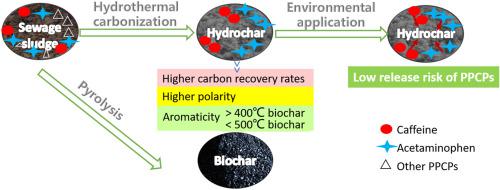Chemosphere ( IF 8.1 ) Pub Date : 2021-06-22 , DOI: 10.1016/j.chemosphere.2021.131313 Fei Wang 1 , Zheyun Yin 2 , Yarui Liu 3 , Hongwen Sun 2 , Hongkai Zhu 2 , Hao Chen 2 , Kai Zhang 2

|
Hydrochars were obtained by hydrothermal carbonization treatment of municipal sewage sludge. Effects of reaction temperature (180–300 °C) and reaction time (2–15 h) on structural characteristics of the hydrochars, and changes and release risk of typical pharmaceuticals and personal care products (PPCPs) in the hydrochars were investigated. Reaction temperature played a more important role than reaction time on hydrochar properties and decarboxylation reaction was the primary process during the converting of sludge to hydrochars. The sludge hydrochars had higher yields, carbon recovery rates, polarity and less aromaticity than biochars. Hydrothermal process reduced PPCPs’ load in sludge hydrochars effectively except caffeine and acetaminophen. The hydrochars prepared at intermediate and high temperatures (240 and 300 °C) had higher caffeine concentrations than the original sludge, which can be ascribed to the transformation of N-containing precursors. The highest CaCl2 extracted caffeine concentration occurred at intermediate temperature of 240 °C (48.1 μg/kg) due to the stronger affinity of caffeine in the high-temperature hydrochars. Caffeine was not detected in hydroxypropyl-β-cyclodextrin (HPCD) extract. Hydrochars prepared at low temperature (180 °C) had a higher acetaminophen concentration than the original sludge, which was attributed to the high thermal stability temperature of acetaminophen. Low- and intermediate-temperature hydrochars had higher CaCl2 extracted acetaminophen concentrations. The HPCD extracted acetaminophen was low with a range of nd to 6.72 μg/kg. In conclusion, PPCPs are less likely to constitute a limiting factor on the farm application of sludge hydrochar. This study provides theoretical support for the safe application of sludge hydrochar in the farmland.
中文翻译:

水热碳化过程中污水污泥中典型药品和个人护理用品的变化及释放风险
Hydrochars 是通过对城市污水污泥进行水热碳化处理而获得的。研究了反应温度(180–300 °C)和反应时间(2–15 h)对加氢碳结构特性的影响,以及加氢碳中典型药物和个人护理产品(PPCPs)的变化和释放风险。反应温度对加氢炭性质的影响比反应时间更重要,脱羧反应是污泥转化为加氢炭的主要过程。与生物炭相比,污泥水化炭具有更高的产量、碳回收率、极性和更少的芳香性。除咖啡因和对乙酰氨基酚外,水热法有效地降低了 PPCPs 在污泥碳氢化合物中的负荷。在中高温(240 和 300 °C)下制备的水碳比原始污泥具有更高的咖啡因浓度,这可以归因于含氮前体的转化。最高的氯化钙2提取的咖啡因浓度发生在 240 °C (48.1 μg/kg) 的中间温度,因为咖啡因在高温烃中的亲和力更强。在羟丙基-β-环糊精 (HPCD) 提取物中未检测到咖啡因。在低温(180°C)下制备的Hydrochars比原始污泥具有更高的对乙酰氨基酚浓度,这归因于对乙酰氨基酚的高热稳定性温度。低温和中温碳氢化合物具有较高的 CaCl 2提取的对乙酰氨基酚浓度。HPCD 提取的对乙酰氨基酚含量低,范围为 nd 至 6.72 μg/kg。总之,PPCPs 不太可能成为污泥水焦的农场应用的限制因素。本研究为污泥水化炭在农田的安全应用提供了理论支持。










































 京公网安备 11010802027423号
京公网安备 11010802027423号